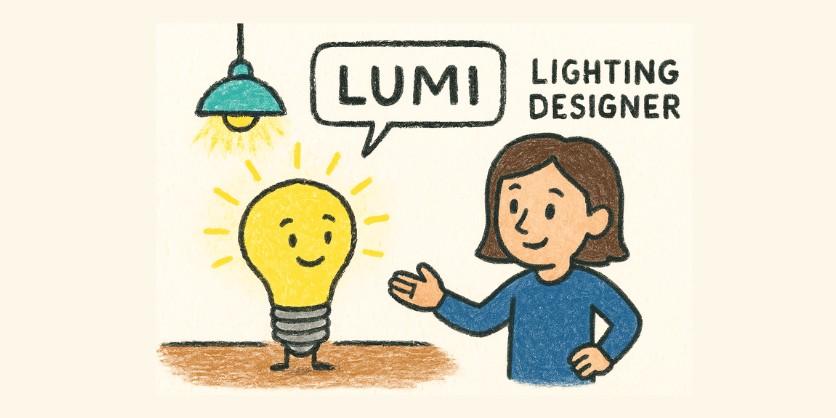The Simplest Way to Explain Lighting Controls to Non-Techies

By Emily Lai, LC
I was talking to some architects recently who have very little lighting control knowledge. To convey the necessary information easily, I explained the process as if they were five year olds — because when we don’t know a subject, we are all essentially five year olds.
Indulge me for a moment by thinking of breaking down the role of lighting controls in this simplistic, fun way.
The Story of Lumi the Light
Once upon a time, in a cozy little house, there lived a light named Lumi.
But Lumi wasn’t just an ordinary light, she was part of a whole team that worked together, just like the parts of a human body.
Let’s meet Lumi’s friends and learn how they help her shine at just the right time.
The Brain – The Controller
Every body needs a brain, and every lighting system does too!
For Lumi, the controller is the brain. Sometimes called the processor.
• It listens to what’s going on.
• It decides what should happen.
• It tells Lumi and her light friends what to do.
Just like your brain tells your arms to wave or your legs to run, the controller tells Lumi when to turn on, how bright to be, and when to rest.
The Eyes & Ears – The Sensors
Lumi doesn’t know who’s around or how bright the sun is outside.
That’s why she needs her friends, the sensors — they’re the eyes and ears of the system.
• Occupancy Sensor (Eyes that see people): “I see someone walk in — time to light up!”
• Daylight Sensor (Eyes that see the sun): “It’s sunny outside — let’s dim down and save energy.”
Together, they help Lumi know when she’s needed and when she can take a nap.
The Hands – The Switches & Touchscreens
Sometimes, people want to take control.
That’s when Lumi listens to the hands of the system — the switches and touchscreens.
• A switch: simple ON or OFF
• A dimmer: turn brightness up or down
• A touchscreen can set whole scenes: movie time, playtime, or bedtime. Lumi and her friends will go to different brightness levels.
Just like your hands can wave, clap, or build, switches and touchscreens let people tell Lumi what to do.
The Voice – The Network
But how do Lumi’s friends talk to each other? Through their voice — the network.
• Sometimes it’s wires carrying messages like little telephone lines.
• Sometimes it’s wireless signals floating through the air like walkie-talkies.
No matter how they speak, the network makes sure every message gets delivered, loud and clear.
The Muscles – The Fixtures
Now, Lumi herself is a fixture — the muscle of the system.
The muscles don’t decide what to do; they just do what the brain says.
• When the brain says, “Shine bright!” Lumi flexes her muscles and glows.
• When it says, “Dim softly,” she relaxes and gives a gentle light.
The Heartbeat – Power Packs
But wait! Muscles need energy. That’s where the powerpacks come in.
They’re like the heartbeat — sending power so Luxy can glow.
• Powerpacks give the right voltage.
• They make sure Lumi has the strength to shine when the controller calls.
The Extra Hands – Interfaces & Contact Closures
Sometimes Lumi’s team talks to other systems — like shades, alarms, or HVAC.
That’s when the interfaces and contact closures join in.
They’re like extra hands reaching out to new friends.
• A fire alarm says, “Lights on full for safety!”
• A shade system says, “Lower the blinds, too sunny!”
These helpers make sure Lumi’s team plays nicely with everyone else.
The Rules – Programming
And here’s the secret: Lumi and her friends follow a routine, just like you do at bedtime.
• Brush teeth → Lights dim
• Storytime → Lights turn cozy
• Sleep → Lights turn off
Programming is like the rules of a game — it keeps the team in rhythm, just like your daily routine.
The Whole Body Working Together
Here’s what happens when Lumi and her friends team up:
1. Occupancy Sensor (eyes) sees you arrive, “Hey, someone’s here!”
2. The Master controller (brain) decides, “Turn on the lights to 70%.”
3. The network (voice) carries the message.
4. Powerpack (heartbeat) delivers power to the fixtures.
5. Lumi, the fixture (muscle), glows warmly.
6. If it’s sunny, the daylight sensor (eyes) says, “Not so bright,” and Lumi dims down.
7. If the contact closure (extra hand) gets an urgent message from the fire alarm, Luxy instantly goes full brightness for safety.
8. If you press a touchscreen (hands) button for “Dance Party,” Lumi switches to colorful lights.
Why Lumi’s Team Matters
• Saves energy (lights rest when not needed).
• Keeps you comfy (not too bright, not too dark).
• Makes life fun (different scenes for different moods).
• Keeps you safe (no more dark hallways).
And They All Lived Brightly Ever After
So, Lumi the light isn’t just a light fixture — she’s part of a smart, living system.
A system with a brain, eyes, ears, hands, voice, muscles, and rules — working together, just like your body.
And thanks to that teamwork, Lumi always shines at the right time, in the right way, for you.
✨ Key Takeaway Bullets (for Big Kids/Designers)
- Master Controller = Brain
- Sensors = Eyes & Ears
- Switches/Touchscreens = Hands
- Network = Voice
- Fixtures = Muscles
- Powerpacks = Heartbeat
- Interfaces/Contact Closures = Extra Hands
About the Author
Emily Lai, LC, is Commercial Regional Sales Manager at ETC
Related articles
The Career Progression of a Lighting Designer: Challenges, Choices & Opportunities
Lighting Control Systems: Why They Matter & How Contractors Can Choose the Right One









